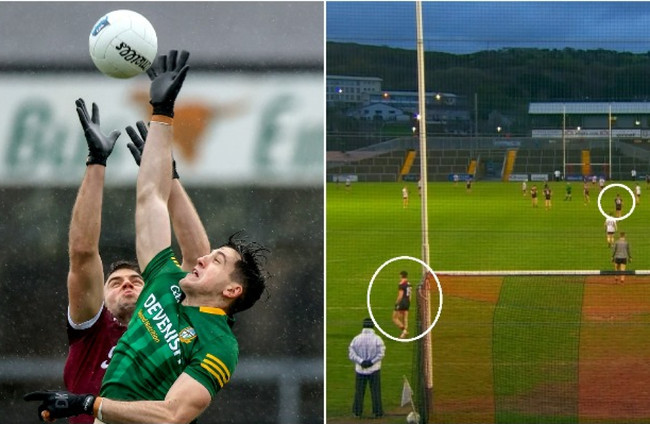WHEN THE 2017 special congress confirmed that every kick-out in Gaelic football must travel a minimum of 13 metres and beyond the 20m line, much was made of the damage this would do to Dublin’s Stephen Cluxton.
He was the greatest promoter of the short kick-out. He weaponised it. If the rule existed for that year’s All-Ireland final, over half of his restarts would have been deemed illegal.
And yet, to focus on that is to overlook a fundamental component of his genius. That day Dublin went to the middle or long with eight kick-outs. They only won two and didn’t score from either. It was also the year they developed the Con O’Callaghan option.
As Brian Fenton and James McCarthy continued to attract more attention and bodies, O’Callaghan would break into the vacant space and utilise his fielding ability.
The point is that even at the time, Dublin used a mix of both. By varying their kick-out and maintaining a long option, it kept opponents guessing. With every full press came the risk that Cluxton could bypass it. As the rules changed they did what they were so good at doing and evolved. Come 2018, Dublin went mid/long with nine, won seven and scored 1-2 from it.
In 2019, Kerry spent several sessions perfecting their full-court press and struck gold early on. By the 11 minute mark, Kerry had 0-2 on the board and missed a penalty. It all came from turning over a short Cluxton kick-out.
He went long with the next four and chalked up 1-1 in a matter of minutes. In total, Dublin went mid/long with eight which resulted in five shots for 1-2.
What outstanding work from @DubGAAOfficial's Jack McCaffrey as he sprinted up the field and scored this goal! Will his skills be as good as they face the Kingdom again in the All-Ireland replay? pic.twitter.com/LRy9gatyGP
— The GAA (@officialgaa) September 4, 2019
It has long been established that retention rates are often meaningless and a better barometer is converted scores, but even that has its flaws. A long kick-out isn’t just a method of quicker attack. It operates as a shot across the bow. A warning that the widely adopted fullcourt press can be punished. Even when a team has strong runners and a successful short kick strategy, they still need to occasionally go long because of what it does to defending teams. It is Gaelic football’s body shot. A probe to make the defence adjust, sometimes even enough to bring opponents crashing down.
It is one thing knowing you need a long kick-out, it is another developing it. In last year’s Connacht final, Galway’s struggles from the re-start were apparent. They lost nine of their own kick-outs. Mayo lost just one of theirs.
In total last year, Galway scored 2-33 from their kick-out. Their opposition, on the other hand, scored 3-40. A similar trend is present after their opening two league games of 2022. They have chalked up 0-3 from their own kick-out. Their opposition have scored 0-5.
Boil it all down and it is obvious Padraic Joyce’s outfit need to improve in this department. The modern game is one where 37% of scores come from teams’ own kick-out.
They know the problem and are actively searching for a solution. 2020 U20 All-Ireland football winning goalkeeper Conor Flaherty has been given the number one jersey for their wins over Meath and Down so far. Speaking after the latter tie, Joyce was upfront about his ambitions for their league campaign.
“Johnny (McGrath) was fabulous. We got caught, Liam Silke had to cry off before the match. We got Johnny in corner-back and he was fantastic. In fairness, he is probably 5’5. He is not the tallest fella but he has a huge heart. I thought he was outstanding.
“A great young fella. The more game time we get into these young fellas the better for Galway. We will always try to get them as much as we can.
“We are down in Division 2. It is our own fault we are in it. We can blame no one else. It is one of our targets to get out of Divison 2. As I said before, if we can win two of our first three games, we are in with a go. We have four out of four now.
“We can relax, enjoy tonight. Pull ourselves together next week. A lot of tired bodies there, an awful lot playing Sigerson and different things. Hopefully, we can clear up some injuries in the next few weeks.”
In those two games, Galway went short with 90% of their kick-outs. The majority of their scores are actually coming from turnovers (2-15). Crucially, they are hampered by two factors. They reside in Division 2 and the wild, windy west.
In both of their opening games, a gale wind was present. Meath did not score in the first half. Down mustered 0-2. As a result, opportunities to stress test their kick-out strategy was severely limited.
Galway were able to press aggressively, even when Down left two players up, because they knew the wind would hamper any attempt to bypass it.
When a rare chance to try a long kick-out presented itself, O’Flaherty demonstrated he can deliver.
Galway boxed off space to allow wing forward Owen Gallagher come from deep.
The Former Antrim ace is well able to field and win marks.
This is the reality of Gaelic football’s second tier and the reason Galway need to secure promotion. As they prepare for the championship, turnovers are easier secured and their weaknesses aren’t interrogated.
It is not like the tests they need are coming any time sooner either. Next up, a winless Offaly travel to Pearse Stadium on the same weekend that a status orange wind warning was issued for the county.







